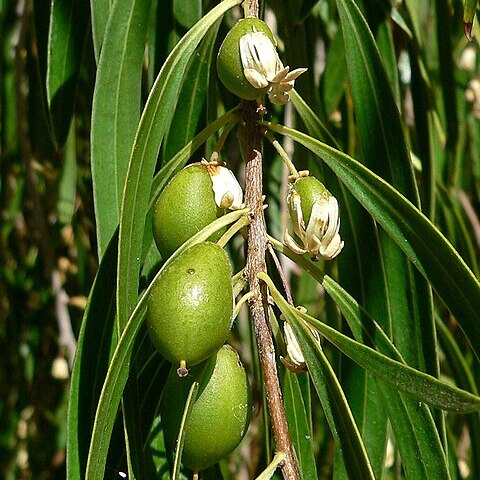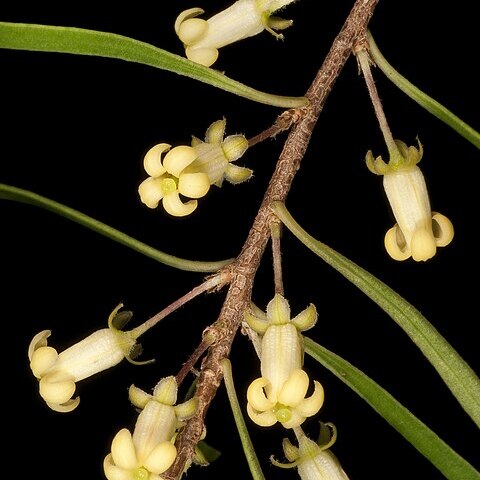Tree to 10 m high, with rounded canopy. New shoots tomentose with a dense indumentum of appressed, grey T-shaped hairs, glabrescent; older stems slightly angular, flaky. Intermediate leaves: lamina narrowly elliptic, to 25 mm long, 6–10 mm wide, apex rounded with a mucro, abaxial surface dense silvery grey hairy; petiole c. 7 mm long, flared at the base and folded. Adult leaves alternate; lamina elliptic, 36–40 mm long, 15–17 mm wide, mucronate, abaxial surface silvery tomentose, eventually glabrescent; petiole 4–6 mm long. Inflorescences are solitary or paired flowers, terminal or axillary, with 2 rows of overlapping bracts and a single c. 4 mm long bracteole at the base of the peduncles; peduncles angular, hairy, c. 5 mm long if terminal, longer if axillary. Sepals tiny, 1–2 mm long, narrowly triangular, margin hairy, revolute. Petals 6–8 mm long, cohering in throat then recurved, yellow, margin sparsely hairy. Male flowers have yellow anthers exserted at petal break with copious pollen; anthers much shorter than filaments, not versatile; filaments thick, tapering; pistil with a slender ovary with few ovules, about the same length as the style, stigma slightly capitate. Female flowers with short, shrivelled staminodes barely reaching a third of the way up the ovary, not exserted; pistil has a thick receptacle and a fat, turgid ovary. Fruit dehiscent, ellipsoid, c. 13 mm long and 8 mm wide, ± truncate base, thickened, unilocular, 2-and 3-valved, brown-orange, with T-shaped hairs towards base, style persisting. Seeds 1–3 per loculus, more globose than reniform, to 4 mm long, red-brown, sticky.
More
A small tree. It grows 4-8 m high. It spreads 2-5 m across. The branches hang down in a weeping fashion. They can droop to near ground level. The bark is pale grey and fairly smooth. The leaves are narrow. They are 5-10 cm long and bright green. They are 6-10 mm wide. They have a smooth, hooked point. The flowers are creamy-yellow. They are small and bell shaped. They occur in masses. They have a perfume. The fruit are orange berries. They split open when ripe to reveal deep red, sticky seeds.



